Mastering day trading using the Relative Strength Index (RSI) involves understanding its role as a momentum oscillator that signals overbought conditions above 70 and oversold conditions below 30. Utilizing RSI for day trading entails customizing settings like period length and levels for optimal performance based on individual preferences and market conditions. Identifying overbought and oversold conditions, recognizing divergences, and combining RSI with other indicators can enhance decision-making. Further exploration of RSI strategies, risk management techniques, hidden divergences, AI integration, and skill enhancement can provide an in-depth guide for successful day trading with RSI.
Understanding Relative Strength Index (RSI)
Analyzing the Relative Strength Index (RSI) provides traders with valuable insights into market dynamics by quantifying the speed and direction of price changes. As a momentum oscillator, the RSI helps traders gauge the strength of a particular market by comparing recent gains and losses over a specified period. This comparison enables traders to assess whether a particular asset is overbought, indicated by RSI values above 70, or oversold, signaled by values below 30. Understanding these overbought and oversold conditions is essential for making informed trading decisions.
The RSI scale, ranging from 0 to 100, offers traders a clear reference point for identifying potential reversal points in the market. By utilizing the RSI, traders can evaluate the relative strength of an asset compared to its previous price movements, aiding in the determination of strategic entry and exit points. Mastering the interpretation of the Relative Strength Index is vital for successful day trading strategies.
Basics of Day Trading With RSI
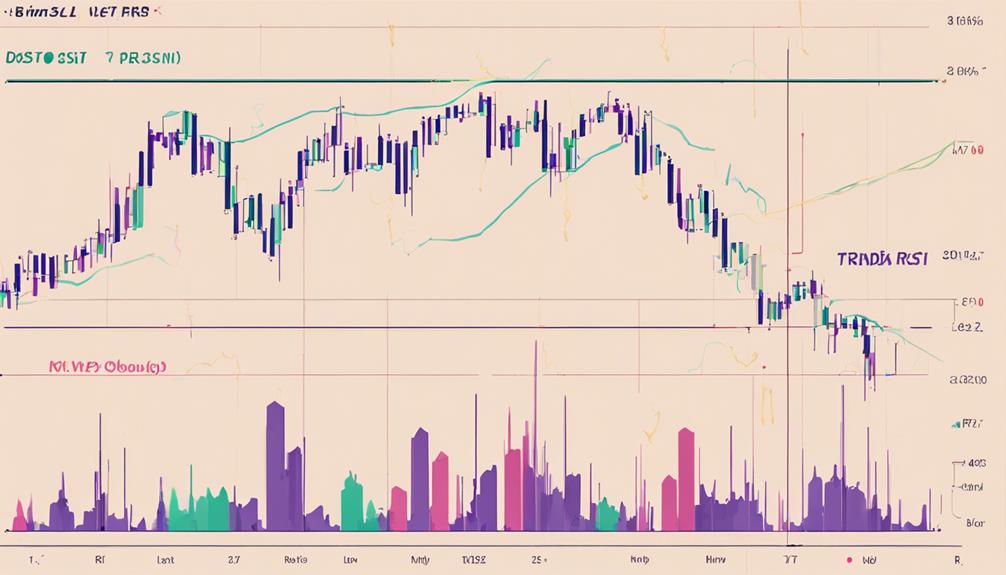
In day trading with RSI, traders leverage a momentum oscillator that assesses the speed and changes in price movements to identify potential buying or selling opportunities based on overbought or oversold levels. When engaging in day trading with RSI, it is important to understand the basics to effectively utilize this tool:
- RSI is a momentum oscillator used to measure the speed and change of price movements.
- RSI values range from 0 to 100, with readings above 70 indicating overbought conditions and below 30 suggesting oversold conditions.
- Traders use RSI to identify potential buying or selling opportunities based on overbought or oversold levels.
- RSI can signal potential trend reversals through bullish or bearish divergences between price movements and RSI values.
- Understanding and applying the concepts of overbought, oversold, and trend reversals are essential when incorporating RSI into day trading strategies. By mastering these basics, traders can enhance their decision-making process and potentially improve their trading outcomes.
Customizing RSI Settings for Day Trading

When customizing RSI settings for day trading, focusing on best parameters, considering different timeframes, and adapting to market volatility are key points to explore.
Understanding how these factors interplay can greatly impact the effectiveness of RSI in guiding trading decisions throughout the day.
Optimal RSI Parameters
Customizing RSI settings for day trading involves adjusting the period length and overbought/oversold levels to align with individual trading preferences and strategies. When determining the best RSI parameters for day trading, consider the following:
- Default Period: The common 14-day RSI period offers a balance between responsiveness and reliability.
- Shorter Periods: Shortening the RSI period to 9 days increases sensitivity to price movements but may result in more false signals.
- Longer Periods: Lengthening the RSI period to 21 days provides smoother signals but might delay trend reversal identification.
- Individual Style: Customize RSI settings based on your trading style, risk tolerance, and market conditions.
- Backtesting: Experiment with different RSI parameters and conduct thorough backtesting to determine the most effective settings for your day trading strategy.
Timeframe Considerations
Adapting the timeframe in consideration of market dynamics and personal trading style plays a pivotal role in refining RSI settings for peak day trading performance. Day traders often opt for customized RSI settings on shorter timeframes, such as RSI 9 or RSI 5, to better capture swift price changes inherent in intraday trading. Shorter RSI periods increase sensitivity to price movements, facilitating rapid decision-making.
Conversely, longer RSI periods like RSI 21 offer smoother signals, ideal for identifying broader trends during day trading activities. Customizing RSI settings based on market volatility and individual trading preferences enhances its efficacy in day trading strategies. By experimenting with various RSI configurations and analyzing backtesting results, traders can fine-tune RSI parameters to align with their specific requirements.
Adapting to Volatility
Amidst the dynamic landscape of day trading, tailoring Relative Strength Index (RSI) settings to accommodate market volatility stands as a pivotal strategy for optimizing intraday performance. When adapting RSI for volatility, traders often adjust the length parameter for shorter timeframes. Lowering the RSI period can help capture rapid price movements in volatile markets, enhancing sensitivity to intraday price fluctuations.
Additionally, reducing the overbought and oversold levels makes RSI more responsive to quick market shifts during day trading. This customization allows traders to align the RSI indicator with the dynamic nature of intraday price action, offering flexibility in identifying and reacting to changes in market momentum.
- Adjust RSI length for shorter timeframes
- Lower overbought and oversold levels
- Capture rapid price movements in volatile markets
- Enhance sensitivity to intraday price fluctuations
- Align RSI with dynamic intraday price action
Identifying Overbought and Oversold Conditions
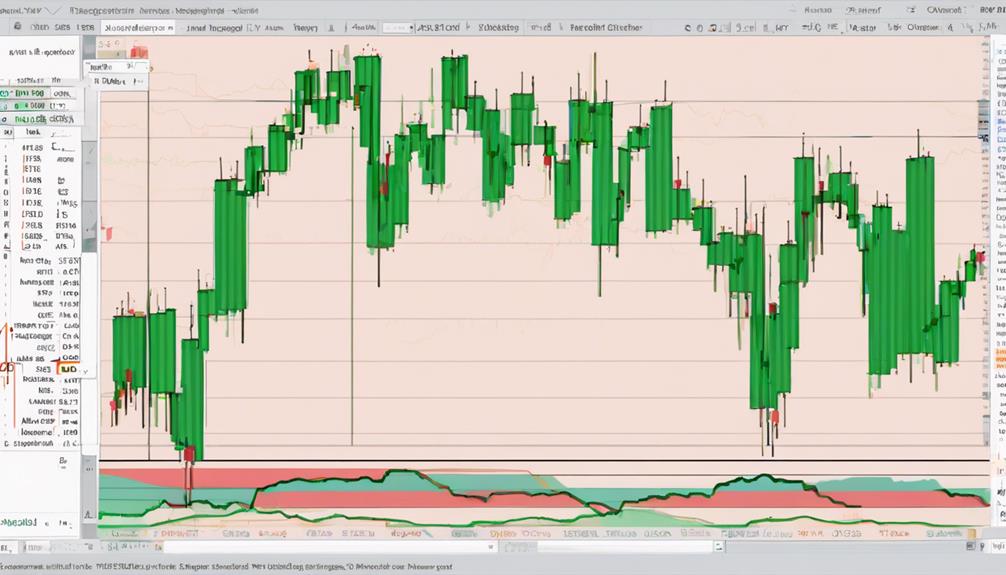
Identifying overbought and oversold conditions in trading is essential for making informed decisions. When the Relative Strength Index (RSI) crosses above 70, it often indicates an overbought market, potentially signaling a reversal.
Conversely, an RSI below 30 suggests an oversold market, presenting potential buying opportunities.
RSI Signals Overbought
RSI values above 70 serve as a key indicator of overbought conditions within the market, prompting traders to assess potential reversal points. When RSI surpasses this threshold, it indicates a potentially overextended market where a reversal to the downside might be imminent. Traders look for signals such as bullish reversal patterns to confirm the likelihood of a price correction. Identifying these overbought conditions can help traders make informed decisions, potentially avoiding buying at a peak. Additionally, understanding that RSI readings below 30 suggest oversold conditions can provide insight into potential buying opportunities. Confirming these signals with other technical indicators can further strengthen trading strategies.
- RSI values above 70 indicate overbought conditions in the market.
- Traders use RSI to identify potential reversal points when the RSI crosses above 70.
- Confirmation signals like bullish reversal patterns are important when RSI indicates overbought conditions.
- Extremely low RSI levels below 20 strengthen the likelihood of buying opportunities in the market.
- RSI readings below 30 suggest oversold conditions where buying opportunities may arise.
Spotting Oversold Conditions
In trading analysis, identifying oversold conditions plays a crucial role in guiding traders towards potential buying opportunities and anticipating price reversals. Oversold conditions are typically recognized when the Relative Strength Index (RSI) falls below 30. RSI levels below 30 signal potential buying opportunities in the market, with extremely low levels below 20 further supporting the presence of oversold conditions. Traders use these RSI indications to anticipate price reversals, and the confirmation of bullish reversal patterns enhances the credibility of the oversold conditions identified. By paying attention to these key RSI levels and patterns, traders can position themselves strategically to capitalize on potential market shifts and make informed trading decisions.
| RSI Levels | Interpretation |
|---|---|
| Below 20 | Strongly Oversold |
| 20-30 | Potential Buying Opportunity |
Avoid Common RSI Mistakes
One common pitfall traders encounter when utilizing the Relative Strength Index (RSI) is the oversight of overbought and oversold conditions, potentially leading to inaccurate trading decisions.
- RSI readings above 70 indicate overbought conditions, while readings below 30 suggest oversold conditions.
- Traders often make the mistake of solely relying on RSI for buy/sell signals, overlooking other market factors.
- Adjusting RSI settings, such as length and overbought/oversold levels, can enhance the indicator's importance.
- Recognizing RSI divergence signals, like bullish and bearish divergences, is essential for identifying potential trend reversals.
- Avoiding misinterpretation of RSI signals and considering market conditions alongside RSI readings is key to effective trading decisions.
Utilizing RSI Divergence in Trading
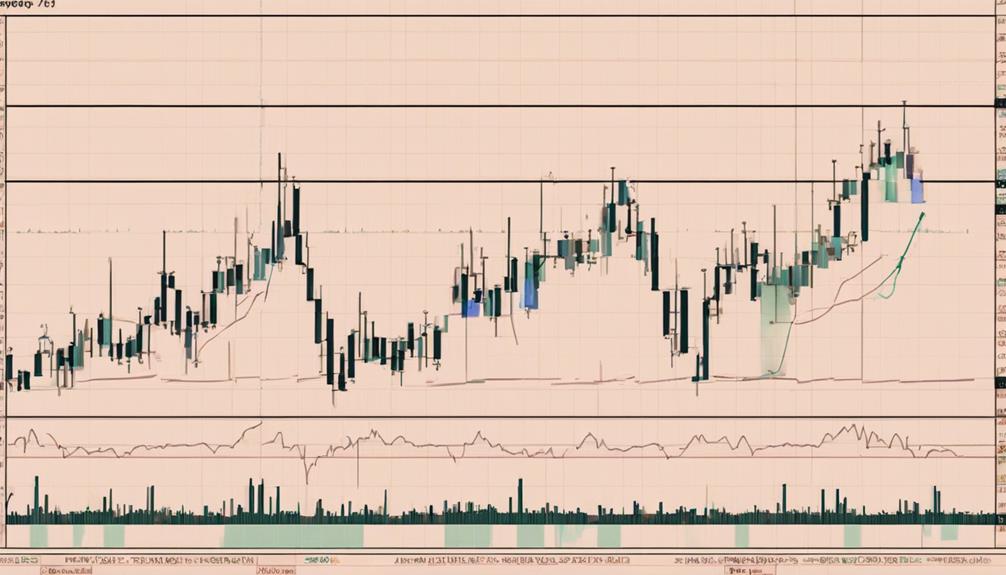
Utilizing divergence signals in trading based on the Relative Strength Index (RSI) can provide traders with valuable insights into potential trend reversals and market dynamics. Bullish divergence occurs when the price forms lower lows while RSI indicates higher lows, suggesting a possible uptrend reversal. On the other hand, bearish divergence is identified by higher highs in price accompanied by lower highs on the RSI, signaling a potential downtrend reversal.
Traders can employ RSI divergence strategies, including hidden bullish and hidden bearish divergences, for more nuanced trading signals. By combining these divergence signals with other technical indicators, traders can enhance the accuracy of their trading decisions. It is essential for traders to practice identifying these divergences to avoid false signals and ultimately improve their trading outcomes.
Mastering the art of recognizing and interpreting RSI divergences can greatly contribute to a trader's success in maneuvering the dynamic landscape of day trading.
Combining RSI With Other Indicators
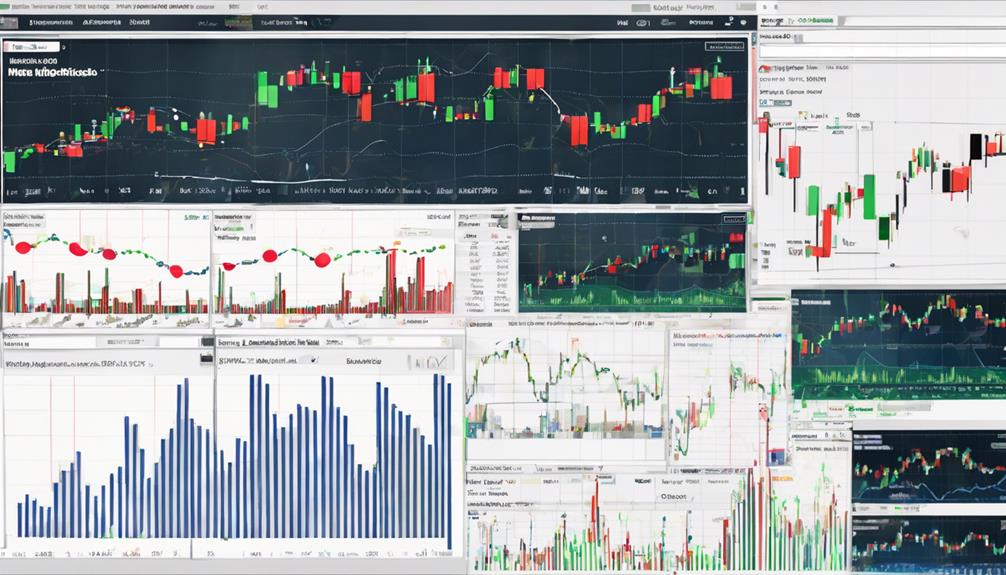
When integrating the Relative Strength Index (RSI) with other technical indicators, traders can enhance their ability to analyze market trends and identify potential trading opportunities. Combining RSI with moving averages and stochastics can provide a more thorough analysis of market conditions and improve the accuracy of trade decisions.
Aligning RSI with these indicators helps in identifying potential divergences and trend reversals, which are vital for traders looking to enter or exit positions effectively. Divergences between RSI and the price of the security being traded can serve as early warnings for changes in price direction, allowing traders to adjust their strategies accordingly.
One important concept to watch for is bullish divergence, where RSI forms higher lows while the price continues to decline, signaling a possible upward reversal. By utilizing these indicators in conjunction with RSI, traders can gain deeper insights into market movements and make more informed trading choices.
Advanced Strategies With RSI

An exploration of advanced strategies with the Relative Strength Index (RSI) involves customizing settings and incorporating various technical indicators to enhance trading precision and decision-making capabilities. By adjusting parameters like the length of the RSI calculation and the overbought/oversold levels, traders can improve the responsiveness and accuracy of this momentum oscillator.
Moreover, combining RSI with other technical indicators such as moving averages and Bollinger Bands can provide more robust trading signals and help confirm potential trend reversals or continuations. Analyzing RSI across different timeframes allows traders to gain a thorough understanding of price movements and identify trends more effectively.
Additionally, utilizing RSI divergence in conjunction with Japanese Candlestick patterns and market structures can offer valuable insights into potential market reversals. Incorporating sound risk management practices, such as setting stop-loss orders and calculating risk-reward ratios, is essential to mitigate losses and ensure long-term success when employing advanced RSI trading strategies.
Implementing Risk Management Techniques

Effective risk management techniques are essential for successful day trading using RSI. Setting stop-loss orders, employing position sizing strategies, and diversifying trade portfolios are key points to take into account.
Setting Stop-Loss Orders
Implementing stop-loss orders based on RSI levels is an essential risk management technique that day traders utilize to protect their investments and minimize potential losses. Traders set stop-loss orders to automatically trigger a sell order at a predetermined price level, often based on RSI readings, to safeguard profits and mitigate risks. This disciplined approach ensures capital protection, especially in volatile markets where sudden price movements can occur. Properly placed stop-loss orders help traders manage risk effectively and optimize their trading strategies. By incorporating these risk management techniques into their day trading routine, traders can enhance their overall performance and protect themselves from significant losses.
- Stop-loss orders automatically trigger sell orders at predetermined prices.
- Traders often base stop-loss levels on RSI readings.
- Stop-loss orders protect profits and minimize risks.
- Discipline is maintained by implementing stop-loss orders.
- Proper risk management helps optimize trading strategies.
Position Sizing Strategies
Position sizing strategies play a pivotal role in day trading by determining the appropriate capital allocation for each trade based on risk tolerance and account size. Day traders employ risk management techniques such as the 2% rule to limit potential losses on individual trades.
Calculating position size using the percentage of total account risked and the distance to the stop loss helps maintain consistent risk across trades. This approach guarantees that no single trade heavily impacts the overall trading account, promoting long-term sustainability.
Effective risk management through proper position sizing is essential for day traders to preserve capital and optimize returns in the volatile trading environment. Consistent application of position sizing strategies is key to managing risk and achieving trading success.
Diversifying Trade Portfolios
To optimize day trading success, diversifying trade portfolios through the implementation of risk management techniques is paramount.
- Risk Management Strategies: Vital for protecting investments and maximizing profitability.
- Stop-Loss Orders: Essential for limiting potential losses and managing risk.
- Position Sizing: Using strategies based on risk tolerance to control exposure in volatile markets.
- Diversification: Spreading investments across different assets or sectors to reduce overall portfolio risk.
- Trailing Stops and Profit Targets: Employed based on market conditions to effectively manage trade positions.
Practicing Divergence Identification
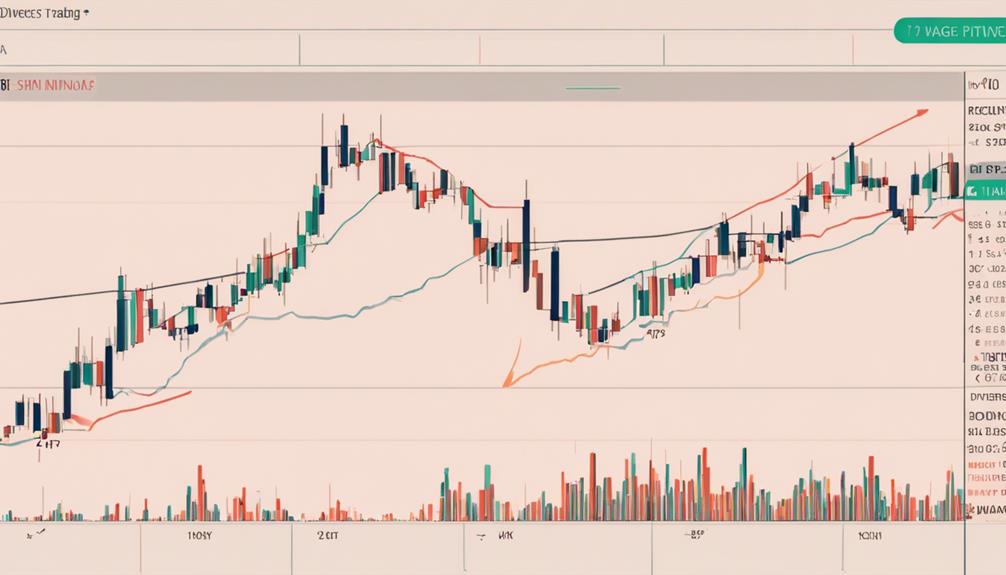
An important aspect of mastering day trading using RSI involves honing the skill of identifying various types of divergences accurately. Divergence identification in RSI is vital for anticipating potential trend changes by analyzing the relationship between price action and RSI movements.
Bullish divergence occurs when the price forms lower lows while RSI forms higher lows, signaling a potential bullish reversal. On the other hand, bearish divergence is identified when price creates higher highs while RSI forms lower highs, indicating a potential bearish reversal.
Hidden bullish divergence suggests underlying strength in an uptrend, seen when price makes higher lows while RSI forms lower lows. Conversely, hidden bearish divergence reveals hidden weakness in a downtrend, observed when price forms lower highs while RSI creates higher highs.
Role of Artificial Intelligence in RSI Trading

The integration of artificial intelligence (AI) in RSI trading revolutionizes the analysis and prediction of market trends by automating data analysis processes efficiently. AI algorithms excel in detecting patterns and trends within RSI data, surpassing manual analysis capabilities.
Machine learning models play a pivotal role in accurately predicting RSI movements and identifying potential trade opportunities. Tools like Tickeron leverage RSI data to generate real-time trading signals, providing traders with valuable insights for decision-making.
The incorporation of AI in RSI trading not only speeds up decision-making processes but also enhances overall trading outcomes through advanced analysis and prediction capabilities. This synergy between AI technology and RSI analysis marks a significant advancement in leveraging data to optimize trading strategies and capitalize on market opportunities.
RSI and Other Technical Indicators
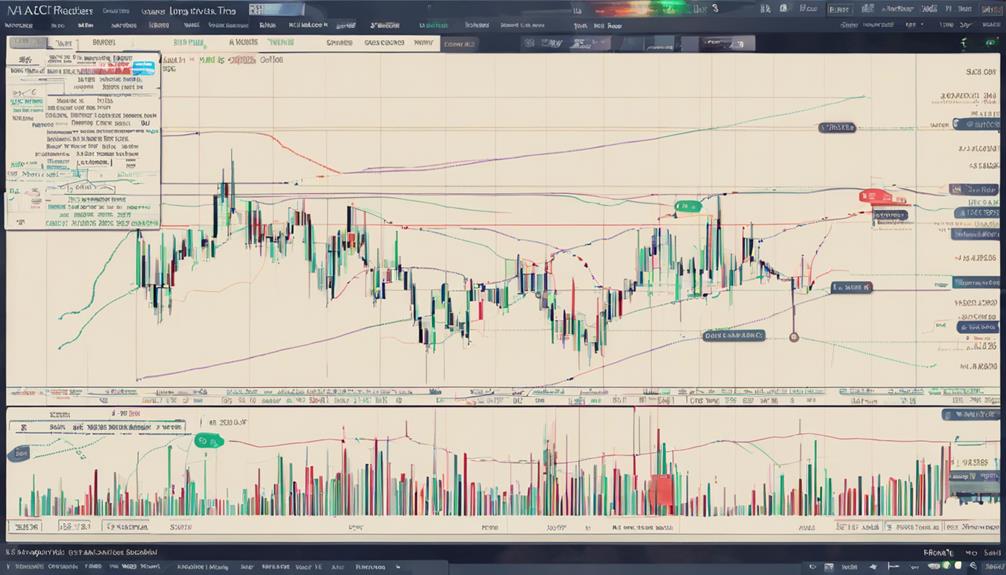
When incorporating Relative Strength Index (RSI) into trading strategies, traders frequently augment their analysis by combining it with moving averages and stochastics for a more in-depth understanding.
By integrating RSI with other technical indicators, traders can gain deeper insights into market trends and potential price movements.
Divergences between RSI and security prices play an important role in signaling possible reversals. For instance, a bullish divergence occurs when RSI displays higher lows, suggesting a potential uptrend in the security's price.
Understanding how RSI interacts with moving averages, stochastics, and other indicators can greatly enhance trading strategies by providing more detailed and reliable signals for decision-making.
Additionally, traders can adjust RSI parameters such as the period length based on market conditions and their preferred trading style to optimize its effectiveness in generating actionable insights.
Enhancing Day Trading Skills

To elevate proficiency in day trading, honing skills through deliberate practice and continuous refinement of strategies is essential. Day traders can enhance their expertise by integrating various aspects of the Relative Strength Index (RSI) into their trading methodologies. Here are five key ways to optimize day trading skills:
- Identifying Potential Reversal Points: Utilize RSI to pinpoint potential reversal points in the market, allowing for timely and strategic trading decisions.
- Integrating Indicators: Combine RSI with other technical indicators to enhance trading accuracy and improve decision-making processes.
- Optimizing Trading Strategies: Understand the nuances of RSI parameters, such as period length, to fine-tune and optimize trading strategies for better outcomes.
- Recognizing Overbought and Oversold Conditions: Use RSI levels to identify overbought and oversold conditions, providing valuable signals for potential trade opportunities.
- Continuous Learning and Practice: Engage in continuous learning and practice with RSI to refine day trading skills over time, staying abreast of market trends and developments.
Can Fibonacci Extensions be Used in Conjunction with RSI for Day Trading?
Fibonacci Extensions can indeed be used in conjunction with RSI for day trading. By mastering stepbystep fibonacci trading mastery, traders can identify potential reversal points and confirm signals from other indicators. Utilizing both tools can enhance trading decisions and improve overall profitability in the market.
Frequently Asked Questions
What Is the Best Strategy for RSI Day Trading?
The best strategy for RSI day trading involves leveraging RSI indicators to pinpoint overbought and oversold conditions. Combine RSI with trend analysis for confirmation signals, identifying ideal entry points.
Implement sound risk management practices and consider different timeframe selections for trade optimization. Backtesting strategies with varied RSI parameters and price action analysis can refine trading approaches for enhanced profitability and risk mitigation.
What Is the 70 30 RSI Strategy?
The 70 30 RSI strategy focuses on RSI overbought signals above 70 and oversold signals below 30. Traders often interpret RSI divergence patterns to anticipate potential trend reversals.
It is important to confirm RSI readings with other technical indicators or price action analysis for enhanced reliability. Additionally, selecting the appropriate timeframe for RSI analysis is essential for ideal entry and exit points in trading decisions.
Do Professional Traders Use Rsi?
Yes, professional traders use RSI signals as part of their technical analysis toolkit to identify potential market entry and exit points.
By combining RSI readings with trading psychology insights, market volatility assessments, risk management strategies, and trend identification techniques, professionals can make more informed trading decisions.
RSI helps traders gauge the strength of price movements and potential reversals, offering valuable information for enhancing trading strategies and optimizing performance in dynamic market conditions.
What Is the RSI 5 Strategy?
The RSI 5 strategy involves utilizing a 5-day period for calculating the Relative Strength Index, focusing on shorter-term trades. It provides intraday signals for entry points, particularly in identifying overbought conditions.
Traders using this strategy must prioritize effective risk management to balance the profit potential associated with frequent trading opportunities. Adjusting RSI settings to a shorter timeframe allows for quicker reactions to price changes, making it suitable for traders seeking rapid signals in dynamic market conditions.
Conclusion
To sum up, mastering day trading using RSI requires a deep understanding of the Relative Strength Index. Customization of settings and identification of overbought and oversold conditions are crucial aspects. Utilization of RSI divergence and integration of artificial intelligence can further enhance trading strategies.
By combining RSI with other technical indicators and consistently practicing and enhancing trading skills, day traders can achieve success in the volatile world of financial markets. As the saying goes, 'practice makes perfect,' and with dedication and knowledge, traders can navigate the complexities of day trading with confidence and precision.


